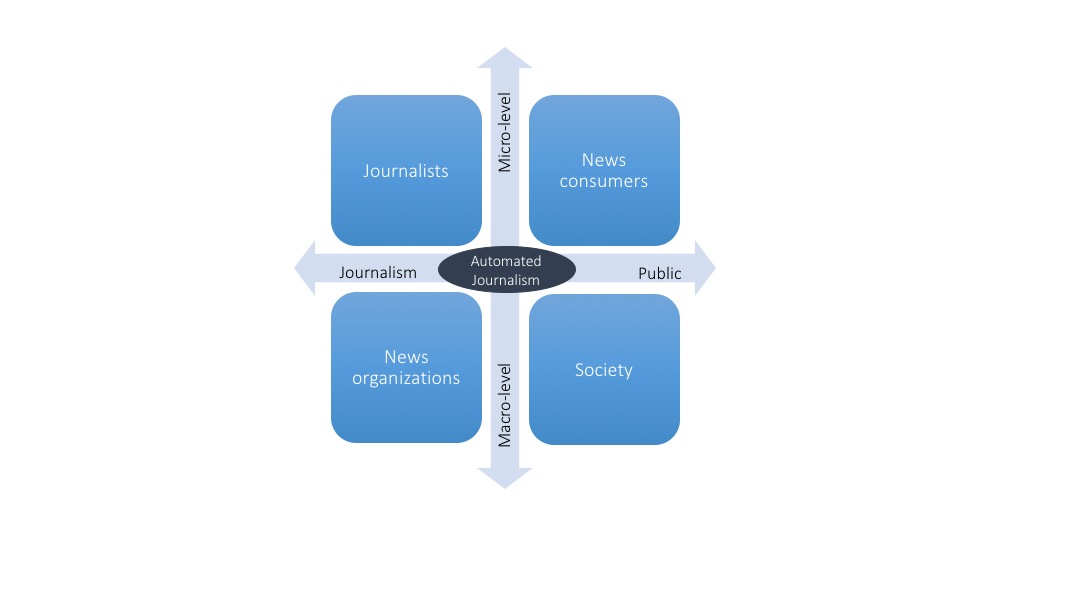For Journalists
Since automated journalism is often perceived as a threat to the livelihood of classic journalism, it is not surprising that it has attracted a lot of attention from journalists. In particular, journalists have focused on the question of how the technology will alter their own roles and required skillsets. Two studies analyzing the content of news articles and blog posts about automated journalism provide insight into journalists’ expectations. The first study analyzed sixty-eight articles published in 2010, which covered Statsheet (the predecessor of Automated Insights), a service that automatically created match reports and previews of all three hundred forty-five NCAA Division 1 college basketball teams.41 The second study analyzed sixty-three articles that reported on Narrative Science’s technology and discussed its impact on journalism.42 The articles were published from 2010 to early 2014 and thus cover a longer and more recent period of journalists’ exposure to automated news.
 Figure 2: Effects of automated journalism
Figure 2: Effects of automated journalism
Both studies found that journalists expected automation to change the way they work, although the extent to which automation technology will replace or complement human journalists will depend on the task and the skills of the journalist. For routine and repetitive tasks, such as sports recaps or company earnings reports—merely a conversion of raw data into standard writing—there was a consensus among journalists that they will not be able to compete with the speed and scale of automated content. Their reaction to this development usually fit either an optimistic or pessimistic frame.
According to the optimistic “machine liberates man” frame, the ability to automate routine tasks may offer opportunities to improve journalistic quality. The argument is that automation frees up journalists from routine tasks and thus allows them to spend more time on providing in-depth analysis, commentary, and investigative work, which are in turn skills that will become more important. This appears to be the case at the Associated Press, which reports that the resources freed up as a result of automation have been used to improve reporting in other areas (see Case Study 3).
According to the pessimistic “machine versus man” frame, automated journalism competes with human journalists. That is, automated journalism is portrayed as yet another way to cut costs and replace those journalists who merely cover routine tasks with software. Indeed, if an increasing share of news will eventually be automated, the logical consequence is that journalists who used to cover such content will need to either produce a better product or focus on tasks and skills for which humans outperform algorithms. As Reginald Chua told me, “journalists have to ask themselves what they bring to the table.”
In their coverage of automated journalism, journalists commonly judged the writing quality of automated content as poor or, at best, “good enough.” They further emphasized humans’ ability to write sophisticated narratives as their own competitive advantage. Yet, although human writing is certainly superior to automated content, at least to date, this debate is somewhat misleading. For one, storytelling is not among the most important skills that journalists commonly mention when defining their profession; those mentioned instead are factors where algorithms excel, such as objectivity, simplification, and speed.43 More importantly, the argument overlooks the fact that automated news is most useful in repetitive, routine, and fact-based stories for which the quality of the writing might not be that essential. For example, when seeking financial news, readers are most interested in quickly obtaining information. In such situations, complex and sophisticated writing may even be counterproductive, making the information harder to understand. This is, of course, the reason why much of the existing financial news writing is rather routine in its following of predefined templates and is thus difficult to distinguish from automated news (see Textbox I).
Rather, journalists are best advised to focus on tasks that algorithms cannot perform. In the future, human and automated journalism will likely become closely integrated and form a relationship that Reginald Chua refers to as a “man-machine marriage.” According to this view, algorithms will analyze data, find interesting stories, and provide a first draft, which journalists will then enrich with more in-depth analyses, interviews with key people, and behind-the-scenes reporting. An early example can be found in crime reporting by the Los Angeles Times’s Homicide Report (Case Study 1), in which an algorithm provides basic facts, such as the date, location, time, age, gender, race, and jurisdiction of a homicide. Then, in the second step, journalists can pick the most interesting stories and add a human touch by providing details about the victim’s life and family.44
Journalists will also take over new roles within the process of automating news production. For example, the Associated Press recently hired a so-called automation editor, whose job is to identify internal processes that can be automated. When it comes to developing news-generating algorithms, a major challenge is defining the rules and criteria that an algorithm is to follow when creating a story from data. While a sports journalist may know from experience which moments in a particular baseball game are game-changing, it can be difficult to translate this knowledge into a rule-based system that can apply to all baseball games. This task requires analytic thinking, creativity, and a certain understanding of statistics. Similarly, so-called meta-writers are required to train the algorithms by defining which words to use for describing a particular event (e.g., when a lead is large or small) or determining the story’s general structure (e.g., the headline informs who won the game, the first paragraph summarizes the score and key events, the rest of the article provides details, etc.).